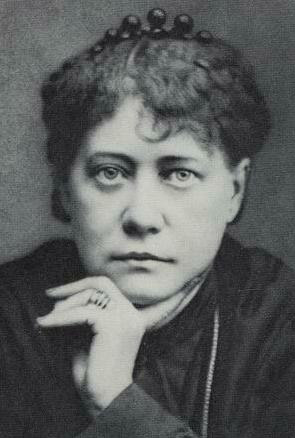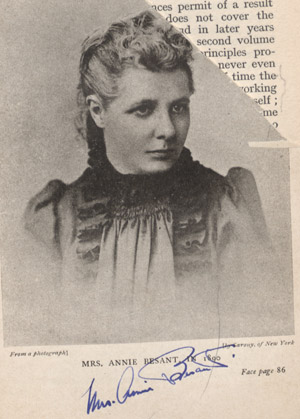Theosophy Reaches Omaha

"If Theosophy can bring back to us some of our lost spirituality, if it stands as any other opponent to our national greed and materialism, it ought surely to be given its place." [1] These words, written by Elia Peattie in 1894 in her column "A Word with the Women" may have been some of her readers' first encounter with the religious movement known as "Theosophy." The faith, which was established in New York in 1875 by Russian mystic and spiritualist Helen Blavatsky, [2] was one of the notable religious trends of the Progressive Age. Theosophy, which literally meant "wisdom concerning God," advocated synthesizing all religious truth into one belief system and was based on the Hindu concepts of karma and reincarnation. [3]
On several occasions, Peattie interviewed leaders of the theosophical movement. Mrs. Annie Besant, who granted her a meeting during a visit to Omaha in 1892, became the president of the Theosophical Society after the death of its original founder. Besant, born in London in 1847, participated in many progressive campaigns during her lifetime. She wrote on behalf of the National Secular Society in England, joined the Marxists, campaigned on behalf of blue-collar workers and participated in their labor strikes, promoted birth control, advocated women's rights, and was well-acquainted with the Indian nationalist movement as an active member of the Indian National Congress. [4] She also co-founded the Hindu University at Varanasi (now Central Hindu College) in 1911, which held as its aim the preparation of Indian youth to be exemplary Hindis through the study of the Hindu holy books and Sanskrit literature. [5]

Blavatsky had set forth the three-fold purpose of her faith in 1879: "1) to form the nucleus of a Universal Brotherhood of Humanity without distinction to creed, race, or color, 2) to promote the study of Aryan and other Eastern literature, religions, and sciences, and vindicate its importance, and 3) to investigate the hidden mysteries of nature and the psychical powers latent in the heart of man." [6] Because Theosophy was based on the synthesis of disparate religious beliefs and philosophies, followers of the faith referred to it as the "harmonial religion."
The rise of Theosophy in America can be viewed against a larger political and religious landscape that, as the nineteenth century drew to a close, had become increasingly tolerant of new ideas. Issues such as labor rights, women's rights, the earlier emancipation of the slaves and their gradual integration into society, and universal suffrage had all worked toward legitimizing freedom of speech in practice, granting voices to sectors of society that had previously been subdued. America slowly continued its evolution toward an increasingly democratic, or populist, society in which political, social, and religious rights were closer to the reality of working class life. As a result of this shift, the religious arena was no longer perceived as the exclusive domain of paid clergy. The common man, as the rise of spiritualism attests, began to inject his own take on matters ecclesiastical into the nation's consciousness, paving the way for the consideration of Theosophy.
The nineteenth century preoccupation with spiritualism further set the stage for this mystical religion. In 1848 mysterious rapping had been heard by sisters Margaret and Catherine Fox at their home in New York. The sounds were unexplainable, emanating strangely from beneath their kitchen table. These two women, who later expressed their views regarding this experience to others, were some of America's first spiritualists. The Foxes proposed what many others had already, albeit privately, believed; those on earth could indeed communicate with whatever lay beyond the grave. The Fox sisters generated so much public interest that P.T Barnum even took them on tour with him, further sparking America's religious imagination.
Many who had already privately believed in the supernatural were happy to have their suspicions legitimized and jumped on the idealistic bandwagon, proclaiming, "Spiritualism is democratic." Famous—and articulate spiritualists of the day included Harriet Beecher Stowe, William Cullen Bryant, James Fennimore Cooper, Susan B. Anthony, and Elizabeth Cady Stanton, who later became well-known for her advocacy of the "Women's Bible." Participants such as these gave credence to the new religious movement. Since many of them had already been on the cutting-edge of other emerging issues, such as women's rights, and could thus speak the language of change, a new religious paradigm was viewed by many Americans as simply in keeping with the times. [7] Theosophy, therefore, was regarded with much greater interest in the 1880s and 1890s than it would have been a few decades earlier. After all, perhaps it was yet another, newly-uncovered path to religious surety.
The founders of the faith, on the other hand, are thought to have wanted a reformation of the common, simple American's approach to deity in order to corral and control the mystic wandering of the populace by refining their beliefs, "uplifting [the] masses out of their supposed philosophical and moral vulgarities–to transcend the masses of prurient ghostseeking spiritualists into ethically exemplary theorists." [8] To this end, they emphasized highly "democratic" ideas, such as reincarnation and the needlessness of religious ritual carried out by trained clergymen. Peattie's revealing—and at times nearly hilarious—interview with Annie Besant reflects her dedication to educating her readership, her practical attention to detail, and also her respect for diversity of thought in the religious realm.
Read Peattie's Writings
References
Goodrick-Clarke, Nicholas, ed. Helena Blavatsky. Berkeley: North Atlantic Books, 2004.
Historic Figures: Annie Besant. 5 October 2007. http://www.bbc.co.uk/history/historic_figures/besant_annie.shtml.
History of the Central Hindu University. 5 October 2007. http://202.141.107.14/Centre/history.html.
Peattie, Elia. "A Talk with Annie Besant." Omaha World-Herald, 29 July 1894: 8.
Prothero, Stephen. "From Spiritualism to Theosophy: 'Uplifting' a Democratic Tradition." Religion and American Culture (Summer 1993): 197-216.
Illustrations
"HP Blavatsky in 1877, New York." Published by The Blavatsky Archives. http://www.blavatskyarchives.com/hpbphotos6.htm
"Annie Besant." Pease, Edward R. The History of the Fabian Society. New York: E.P. Dutton & Company. 1916.
Notes
XML: ep.owh.rel.0007.xml
